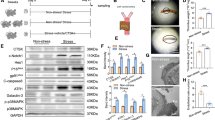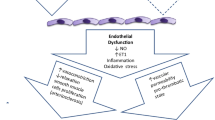Abstract
Pathological levels of homocysteine induce a dramatic degradation of arterial elastic structures. This severe metalloproteinase-dependant elastolysis affects elastic structures all over the media suggesting that smooth muscle cells (SMC) may participate to this process induced by homocysteine. Therefore, we investigated the effect of physiological (10 μM) and pathological (50, 100, and 500 μM) concentrations of homocysteine on the metalloproteinase-dependant proteolytic potential of human arterial SMC in culture. Pathological levels of homocysteine increased concomitantly the secretion of latent MMP-2 and TIMP-2 while the secretion of other elastolytic matrix metalloproteinases (MMPs) and expression of MT1-MMP were not altered. The increased secretion of latent MMP-2 induced by homocysteine was associated with an increased production of reactive oxygen species (ROS). Moreover, the increased secretion of latent MMP-2 induced by homocysteine was inhibited by antioxidant superoxide dismutase alone or in combination with catalase. These results suggest that SMC could participate, through an oxidative stress dependant secretion of elastolytic MMP-2, to the metalloproteinase-dependant degradation of arterial elastic structures induced by homocysteine.






Similar content being viewed by others
References
McCully KS (1983) Homocysteine theory of arteriosclerosis: development and current status. Atheroscler Rev 11:157–246
Eikelboom JW, Lonn E, Genest J Jr, Hankey G, Yusuf S (1999) Homocyst(e)ine and cardiovascular disease: a critical review of the epidemiologic evidenc. Ann Intern Med 131:363–375
Wang H, Jiang X, Yang F, Gaubatz JW, Ma L, Magera MJ, Yang X, Berger PB, Durante W, Pownall HJ, Schafer AI (2003) Hyperhomocysteinemia accelerates atherosclerosis in cystathionine beta-synthase and apolipoprotein E double knock-out mice with and without dietary perturbation. Blood 101:3901–3907
Hofmann MA, Lalla E, Lu Y, Gleason MR, Wolf BM, Tanji N, Ferran LJ Jr, Kohl B, Rao V, Kisiel V, Stern DM, Schmidt AM (2001) Hyperhomocysteinemia enhances vascular inflammation and accelerates atherosclerosis in a murine model. J Clin Invest 107:675–683
Austin RC, Lentz SR, Werstuck GH (2004) Role of hyperhomocysteinemia in endothelial dysfunction and atherothrombotic disease. Cell Death Differ 11(Suppl 1):S56–S64
Tsai MY, Arnett DK, Eckfeldt JH, Williams RR, Ellison RC (2000) Plasma homocysteine and its association with carotid intimal-medial wall thickness and prevalent coronary heart disease: NHLBI Family Heart Study. Atherosclerosis 151:519–524
Rolland PH, Friggi A, Barlatier A, Piquet P, Latrille V, Faye MM, Guillou J, Charpiot P, Bodard H, Ghiringhelli O et al (1995) Hyperhomocysteinemia-induced vascular damage in the minipig. Captopril-hydrochlorothiazide combination prevents elastic alterations. Circulation 91:1161–1174
Charpiot P, Bescond A, Augier T, Chareyre C, Fraterno M, Rolland PH, Garcon D (1998) Hyperhomocysteinemia induces elastolysis in minipig arteries: structural consequences, arterial site specificity and effect of captopril-hydrochlorothiazide. Matrix Biol 17:559–574
Augier T, Charpiot P, Chareyre C, Remusat M, Rolland PH, Garcon D (1997) Medial elastic structure alterations in atherosclerotic arteries in minipigs: plaque proximity and arterial site specificity. Matrix Biol 15:455–467
Chaussalet M, Lamy E, Foucault-Bertaud A, Genovesio C, Sabatier F, Dignat-George F, Charpiot P (2004) Homocysteine modulates the proteolytic potential of human vascular endothelial cells. Biochem Biophys Res Commun 316:170–176
Senior RM, Griffin GL, Fliszar CJ, Shapiro SD, Goldberg GI, Welgus HG (1991) Human 92- and 72-kilodalton type IV collagenases are elastases. J Biol Chem 266:7870–7875
Quantin B, Murphy G, Breathnach R (1989) Pump-1 cDNA codes for a protein with characteristics similar to those of classical collagenase family members. Biochemistry 28:5327–5334
Nelson KK, Melendez JA (2004) Mitochondrial redox control of matrix metalloproteinases. Free Radic Biol Med 37:768–784
Papatheodorou L, Weiss N (2007) Vascular oxidant stress and inflammation in hyperhomocysteinemia. Antioxid Redox Signal 9:1941–1958
Grenier G, Remy-Zolghadri M, Guignard R, Bergeron F, Labbe R, Auger FA, Germain L (2003) Isolation and culture of the three vascular cell types from a small vein biopsy sample. In Vitro Cell Dev Biol Anim 39:131–139
Laemmli UK (1970) Cleavage of structural proteins during the assembly of the head of bacteriophage T4. Nature 227:680–685
Wang H, Joseph JA (1999) Quantifying cellular oxidative stress by dichlorofluorescein assay using microplate reader. Free Radic Biol Med 27:612–616
Mountain DJ, Singh M, Menon B, Singh K (2007) Interleukin-1beta increases expression and activity of matrix metalloproteinase-2 in cardiac microvascular endothelial cells: role of PKCalpha/beta1 and MAPKs. Am J Physiol Cell Physiol 292:C867–C875
Su B, Mitra S, Gregg H, Flavahan S, Chotani MA, Clark KR, Goldschmidt-Clermont PJ, Flavahan NA (2001) Redox regulation of vascular smooth muscle cell differentiation. Circ Res 89:39–46
Knox JB, Sukhova GK, Whittemore AD, Libby P (1997) Evidence for altered balance between matrix metalloproteinases and their inhibitors in human aortic diseases. Circulation 95:205–212
Sasaguri Y, Murahashi N, Sugama K, Kato S, Hiraoka K, Satoh T, Isomoto H, Morimatsu M (1994) Development-related changes in matrix metalloproteinase expression in human aortic smooth muscle cells. Lab Invest 71:261–269
Lee HY, Chae IH, Kim HS, Park YB, Choi YS, Lee YW, Park SJ, Cha YJ (2002) Differential effects of homocysteine on porcine endothelial and vascular smooth muscle cells. J Cardiovasc Pharmacol 39:643–651
Murphy G, Crabbe T (1995) Gelatinases A and B. Methods Enzymol 248:470–484
Bescond A, Augier T, Chareyre C, Garcon D, Hornebeck W, Charpiot P (1999) Influence of homocysteine on matrix metalloproteinase-2: activation and activity. Biochem Biophys Res Commun 263:498–503
Goldberg GI, Marmer BL, Grant GA, Eisen AZ, Wilhelm S, He CS (1989) Human 72-kilodalton type IV collagenase forms a complex with a tissue inhibitor of metalloproteases designated TIMP-2. Proc Natl Acad Sci USA 86:8207–8211
Doronzo G, Russo I, Mattiello L, Trovati M, Anfossi G (2005) Homocysteine rapidly increases matrix metalloproteinase-2 expression and activity in cultured human vascular smooth muscle cells. Role of phosphatidyl inositol 3-kinase and mitogen activated protein kinase pathways. Thromb Haemost 94:1285–1293
Guo H, Wang P, You B, Xing Y, Lee JD (2007) Chinese yellow wine inhibits production of homocysteine-induced extracellular matrix metalloproteinase-2 in cultured rat vascular smooth muscle cells. Clin Nutr 26:348–354
Nagase H (1997) Activation mechanisms of matrix metalloproteinases. Biol Chem 378:151–160
Owens GK, Kumar MS, Wamhoff BR (2004) Molecular regulation of vascular smooth muscle cell differentiation in development and disease. Physiol Rev 84:767–801
Berton A, Godeau G, Emonard H, Baba K, Bellon P, Hornebeck W, Bellon G (2000) Analysis of the ex vivo specificity of human gelatinases A and B towards skin collagen and elastic fibers by computerized morphometry. Matrix Biol 19:139–148
Emonard H, Hornebeck W (1997) Binding of 92 kDa and 72 kDa progelatinases to insoluble elastin modulates their proteolytic activation. Biol Chem 378:265–271
Schanstra JP, Neau E, Drogoz P, Arevalo Gomez MA, Lopez Novoa JM, Calise D, Pecher C, Bader M, Girolami JP, Bascands JL (2002) In vivo bradykinin B2 receptor activation reduces renal fibrosis. J Clin Invest 110:371–379
Luchtefeld M, Grote K, Grothusen C, Bley S, Bandlow N, Selle T, Struber M, Haverich A, Bavendiek U, Drexler H, Schieffer B (2005) Angiotensin II induces MMP-2 in a p47phox-dependent manner. Biochem Biophys Res Commun 328:183–188
Kawaguchi Y, Tanaka H, Okada T, Konishi H, Takahashi M, Ito M, Asai J (1996) The effects of ultraviolet A and reactive oxygen species on the mRNA expression of 72-kDa type IV collagenase and its tissue inhibitor in cultured human dermal fibroblasts. Arch Dermatol Res 288:39–44
Clempus RE, Sorescu D, Dikalova AE, Pounkova L, Jo P, Sorescu GP, Lassegue B, Griendling KK (2007) Nox4 is required for maintenance of the differentiated vascular smooth muscle cell phenotype. Arterioscler Thromb Vasc Biol 27:42–48
Author information
Authors and Affiliations
Corresponding author
Rights and permissions
About this article
Cite this article
Ke, X.D., Foucault-Bertaud, A., Genovesio, C. et al. Homocysteine modulates the proteolytic potential of human arterial smooth muscle cells through a reactive oxygen species dependant mechanism. Mol Cell Biochem 335, 203–210 (2010). https://doi.org/10.1007/s11010-009-0270-7
Received:
Accepted:
Published:
Issue Date:
DOI: https://doi.org/10.1007/s11010-009-0270-7




